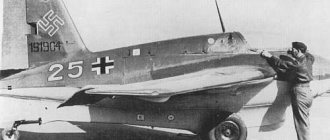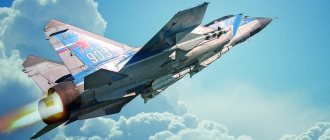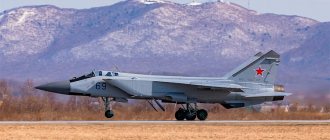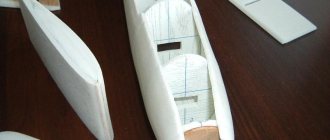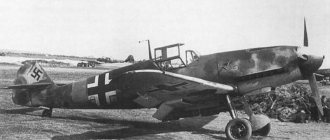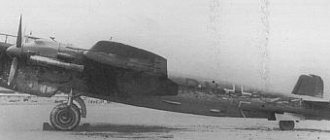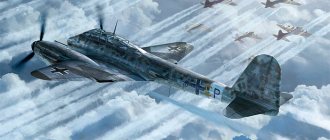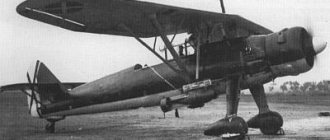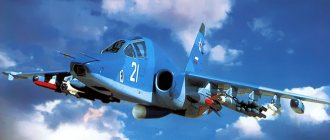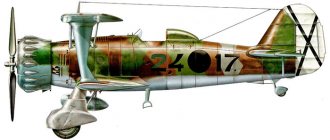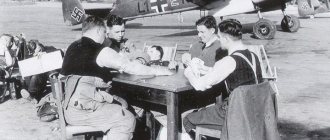In the mid-30s. Leading aircraft manufacturing firms in Germany took part in a competition to create a combat aircraft of the hitherto unknown “strategic fighter” class. According to the Luftwaffe command, the aircraft was to be used to gain air superiority over enemy territory and to escort long-range bombers. It was also intended to perform the tasks of a long-range fighter-interceptor, reconnaissance aircraft and fighter-bomber.
Of the projects presented to the Luftwaffe commission for consideration by the Henschel Hs-124, Focke-Wulf Fw-57 and Bayerische Flugzeugwerke Bf-110, the Bf 110 project was recognized as the best. The project was developed by Willy Messerschmitt and after coming under his control the Bf-110 was often designated also as Me -110.
Messerschmitt Bf110
Testing of the first three prototypes of the Bf 110 began in the spring of 1935 (first flight on May 12, 1935); in 1937, the Bf 110 fighter was adopted by the Luftwaffe and put into mass production. A pre-production batch of four vehicles was manufactured the same year. It was an all-metal twin-engine monoplane with a low wing and a spaced tail.
Prototypes of the Bf 110 flew with DB 600A engines producing 910 hp each. With. every. With these engines, the planes reached speeds of up to 510 km/h.
The bulk of the production Bf 110s were produced with 12-cylinder water-cooled DB 601 engines of various modifications with a power of 1050-1350 hp. With. The engines drove three-blade VDM propellers with electrically controlled pitch and the blades were set in a feathered position.
The aircraft's equipment was largely determined by its purpose. However, most machines were equipped with a set of instruments for long-distance flights; a Patin remote compass with electrical data supply to the pointer was mounted in the rear fuselage, and a Sperry gyrocompass was placed on the instrument panel in the pilot’s cockpit. Standard equipment was the FuG 10 radio station with short-wave and long-wave transceiver units, radio navigation and blind landing units. The total weight of the radio station was 162 kg.
The aircraft's armament was also determined by its purpose. The strike fighter modification was armed with four 7.92 mm MG 17 machine guns, two 20 mm MG FF or MG 151/20 cannons and one movable 7.92 mm MG 81Z or MG 15 machine gun.
In addition to the armament set described above, on some modifications of the Bf 110, four MG 17 machine guns were replaced by two extremely powerful 30-mm MK 108 cannons. On other modifications, the machine guns were retained, while the MK 108 cannons were replaced by MG FF cannons. One of the modifications of the night fighter-interceptor was armed with two 30 -mm MK 108 cannons in the forward part of the fuselage and two of the same cannons installed in the rear of the cockpit for firing upward and forward (the “Schrage Musik” scheme). This modification was used to attack formations of Allied heavy bombers from below. Aiming was carried out by the pilot through a special collimator sight.
In addition to the built-in weapons, the Bf 110 could also carry a variety of external weapons. When used in the fighter-bomber version, this could be two bombs weighing up to 1000 kg under the fuselage and another four 50 kg bombs under the wing, which was more than .3.5 times the normal bomb load of the standard Soviet Pe-2 bomber. Sometimes, instead of bomb racks, containers with two 20 mm cannons or one 37 mm cannon were suspended under the fuselage. Night fighter-interceptors were also armed with four launchers of 210-mm Wgr 21 rockets.
Despite its good speed characteristics and powerful weapons, the Bf 110 turned out to be unsuitable for combat missions as a fighter. In terms of climb rate and maneuverability, it was inferior to all the main enemy fighters, which was mainly due to the insufficient engine power for such a heavy vehicle. The plane climbed to an altitude of 5000 m in approximately 8.4 minutes, and completed a full turn at an altitude of 1000 m in 30 seconds. For comparison: the British Spitfire Mk. The VB climbed to a height of 6100 m in 6 minutes 24 seconds, and took 18.8 seconds to turn.
The heavy losses suffered by the squadrons armed with Bf 110 fighters forced the Luftwaffe command to redirect them to conducting reconnaissance, bombing strikes and long-range interception of enemy bombers. However, the Bf 110 was most successfully used as a night air defense interceptor fighter. In the forward fuselage of the Bf 110 there was enough space to accommodate bulky radar equipment, and the increased aerodynamic drag due to antennas protruding in all directions was to some extent compensated by an increase in the power of the engines installed on the aircraft.
In this capacity, the Bf 110 turned out to be more effective not only than the Ju 88 and Do 217 bombers converted into interceptors, but also the latest He 219 fighter-interceptors. At the beginning of 1944, the Reich air defense system used 320 Bf 110 of various modifications, which accounted for about 60% of the total number of air defense fighters.
Production of the Bf 110 continued until March 1945 and was stopped only after Soviet tanks broke into the Messerschmitt plant.
Combat use of Messerschmitt Bf-110 (Me-110)
By the time the Second World War began, the Messerschmitt Bf-110 was at the stage of introduction into the Luftwaffe - of the 12 planned Zersterer groups[], only three were armed with them: l(Z)/LG 1 (Bf-110С), as well as I/ ZG 1 and I/ZG 76 (Bf-110В/С), two more were in the stage of rearmament. In the Polish campaign and Operation Weserubung, the Bf-110 was used as a long-range fighter. The blitzkrieg in the West in May-June 1940 already involved 9 groups of Bf-110s, involved in escorting bombers and fighting for air supremacy. At the same time, quite significant losses were suffered - 82 aircraft, almost a quarter of the initial composition of the groups.
8 groups of Zerschterers took part in the “Battle of Britain”, as well as a group of Erpr.Gr fighter-bombers partially armed with Bf-110C/D. 210. By September 7, 1940, in four of the eight groups of “destroyers” there was not a single serviceable aircraft left - it became clear that the Bf-110 had exhausted itself as an escort fighter. However, it continued to be used as a fighter-bomber.
At the beginning of 1941, Group III/ZG 26 (Bf-110C/D) arrived in Sicily, from where it took part in raids on Malta, and then operated in North Africa. I and II/ZG 26 (Bf-110C/E) took part in the war against Yugoslavia and Greece in April 1941, and in May, together with II/ZG 76, in the capture of Crete.
By the time of the attack on the Soviet Union, the Bf-110 was considered primarily not as an escort fighter, but as a high-speed attack vehicle. Four groups of such aircraft took part in Operation Barbarossa - I and II/SKG 210, as well as I and II/ZG 26. They carried out bombing attacks on airfields, railway junctions, columns and concentrations of troops, operating in the zone of Army Group Center. . At the end of August-September 1941, Groups I and II/ZG 26 operated in the Leningrad area, and subsequently again in the zone of Army Group Center.
In the spring of 1942, only 2 Zerschterer groups remained on the Eastern Front - I and II/ZG 1, which, in addition to the Bf-110E, were armed with new Bf-110F-2. In May-August 1942, I and II/ZG 2 also fought here, soon transferred to the Reich to man air defense units. In 1942, the “destroyers” fought mainly on the southern sector of the front - over Ukraine, Don and Kuban, as well as Stalingrad. They were used almost exclusively as percussion instruments. The last group of Bf-110s to operate on the Eastern Front was I/ZG 1, which took part in the Battle of Kursk in the summer of 1943 and was then withdrawn to Germany.
The fiasco of the Zersterer concept, which became obvious already during the Battle of Britain, by no means put an end to the career of the Bf-110. Although these aircraft continued to be used at the front as attack vehicles, a much larger number of “one hundred tenths” served to protect the airspace of the Reich in night fighter squadrons. At first, these formations received ordinary Me-110 Zersterers of modifications C, D and E, but in the spring of 1942, full-scale deliveries of radar-equipped Bf-110F-4 aircraft began. In 1942-1944. Bf-110s were the main armament of seven night fighter squadrons; In addition, ordinary Zersterer groups operating during the day were also involved in air defense. The Bf-110 was much better suited for radar installations than the more modern Me-210/410, although its speed and flight endurance were considered insufficient.
The Bf-110 was exported in very limited quantities. In 1940, the USSR acquired 5 Bf-110С-4 for testing. In 1942, three Bf-110Cs were delivered to Italy, where they were used to train night fighter crews. 2-3 Bf-110s were used as trainers in Romania. At the end of 1944, Germany transferred several Bf-110F-4 and 6 Bf-110G-4 to the 101st Night Fighter Squadron of the Hungarian Air Force.
Generated by the Douay Doctrine, the Bf-110 was used for a very short time in the capacity in which it was intended - as a long-range escort and air superiority fighter. Already in the summer of 1940 it became clear that the machine was not suitable for these purposes. However, the design of the Messerschmitt Bf-110 was suitable for modification, and the vehicle was adapted to the role of a high-speed bomber, reconnaissance aircraft and, finally, a night fighter. After the Polish campaign, the Bf-110 proved indispensable in the capture of Norway, participated in the blitzkrieg in the West and the “Battle of Britain”. On the Eastern Front, shock functions became the main ones for the “one hundred and tenth”. Finally equipped with radar, it became the main type of night fighter in the Reich defense forces. Despite a number of “inherent” shortcomings (primarily the short flight range), the Bf-110 remained in production until February 1945, and was actually used in battle until the last days of the war.
Me-110 heavy German twin-engine fighter that fought throughout the war
The Messerschmitt Bf-110 fighter appeared in the mid-30s of the last century, but the very concept of a multi-seat heavy escort fighter with a long flight range was formulated during the First World War. Then the warring parties felt the need for a fighter that would be capable of accompanying bombers deep in the enemy’s defenses. Also, such an aircraft was supposed to carry out the task of barrage patrols on the distant approaches to their bases. However, the technical capabilities of that time did not allow the creation of such an aircraft, and interest in it arose again only after 1933, when Germany’s aggressive policy gave a new impetus to the development of a long-range fighter. Work on the creation of such a fighter began in 1934. Already in 1938, Messerschmitt designed and built an escort and air defense fighter. A prototype of the Me-110 fighter was tested at the end of 1938 and went into production in the spring of 1939. During the war, the aircraft was assigned the tasks of attack aircraft, bomber, and reconnaissance aircraft, and therefore the aircraft was constantly subject to modernization. All modifications differed mainly in the layout of the armor and weapons, as well as the ability to install additional beams for special equipment, mounting bombs and fuel tanks.
Design Features
The Me-110 fighter is a two-seat, twin-engine, cantilever all-metal monoplane with a low wing, retractable landing gear and spaced tail surfaces. The aircraft wing has a trapezoidal shape with slightly rounded ends. The wing is a metal wing of single-spar construction with a smooth working skin made of duralumin sheets. The spar is of beam type, located perpendicular to the axis of the aircraft. The spar flanges consist of steel plates and angles of varying cross-section. Between the fuselage of the aircraft and the engine nacelles there are additional power beams - tail and nose. Together with the spar, they form 2 compartments on each side of the aircraft to accommodate gas tanks.
The fuselage of the aircraft is an all-duralumin monocoque with an oval cross-section. The maximum width of the fuselage at the location of the pilot's cabin is 0.94 meters. The removable short nose section is attached to it at four points; a truss passes through the fuselage, which is a continuation of the wing spar. The fighter's cockpit is closed with a sliding plexiglass canopy. The side and front windows are flat. To fire from the rear machine gun, part of the gunner-radio operator's canopy is raised. The pilot's canopy in the air can only be opened in the event of an emergency.
The design of the aircraft was initially designed for mass production; the technology of the fighter is simple. In order to speed up the production process, its units are made up of simple subassemblies and parts. In its design, standard normals and parts are widely used, especially in the control groups and the propeller group (pipe connectors, plugs, lugs, etc.).
The Me-110C aircraft was equipped with two 12-cylinder V-shaped inverted liquid-cooled DB-601A engines. Their takeoff power was 1175 hp. at 2500 rpm. rated power - 1050 hp. at 2400 rpm, at an altitude of 4100 meters. The engines ran on fuel with an octane rating of 87 (on the German scale). Later versions of the aircraft F, G and H used DB 605B-1 engines, which had a power of 1475 hp. on takeoff and 1355 hp. at an altitude of 5700 meters. The maximum speed of the aircraft reached 560 km/h. The engine installation, due to the rear position of the spar, was deeply immersed in the wing, which made it possible to significantly shorten the engine nacelles to increase the pilot's lateral visibility.
The fighter's fuel supply was located in 4 gas tanks located in the wing, between the fuselage and engine nacelles. Their total capacity was 1270 liters. Two main tanks with a capacity of 375 liters were installed in front of the spar, two reserve tanks of 270 liters each were installed behind. Each gas tank was equipped with an electric gas pump mounted in the upper part of the tank. The electric fuel pumps of the reserve tanks are designed to pump fuel to the main tanks, while the gas pumps of the main tanks supplied fuel to the engine on flights above 5000 meters. The fuel level indicators in the cockpit had a common indicator for all tanks. There was no provision for emergency fuel drainage.
Armament
The fighter's armament consisted of 2 MG-FF cannons of 20 mm caliber and 4 MG-17 machine guns of 7.92 mm caliber, which were installed in the forward part of the fuselage. To protect the rear hemisphere, 1 MG-15 machine gun of 7.92 mm caliber was installed in the gunner’s cockpit. Access to the fixed machine guns was through the upper half of the forward fuselage, which moved forward. The guns were mounted on a carriage and accessed through an easily removable hatch located under the fuselage.
The supply of cartridges for the front machine guns was 4,000 (1,000 per barrel), the supply of cartridges for the rear machine gun was 750. The ammunition for the guns was 360 rounds. The front machine guns were fed by a belt, while the rear machine gun was magazine-fed; the gunner-radio operator had to change spent magazines. The fixed weapon had a collimator sight, and fire control was concentrated on the pilot. Electric release, electro-pneumatic reloading.
The placement and design of small arms and cannon weapons ensured the convenience of combat operations by the crew in the air and the work of maintenance personnel. The approach to the cannons and machine guns, the sight and all other components of the weapon system was good. Loading and unloading weapons, as well as installing and removing cartridge boxes did not present any difficulties.
Application and controllability
The Me-110 fighter was distinguished by good controllability, stability and maneuverability. It was possible to fly for a long time with the pilot completely in control. In terms of piloting technique, the aircraft was quite accessible and simple for pilots of average skill. The fighter allowed the pilot to fly with one engine running, while the propeller blades of the stopped engine were feathered.
The aircraft was first used by the Germans during their invasion of Poland in September 1939. It was subsequently widely used during campaigns against Denmark, Norway, Belgium, Holland, France, Great Britain, Greece and Yugoslavia. If in the initial periods of the Second World War the aircraft coped well with the task of fighting enemy fighters (weaker), then the very first meeting with the British Spitfires during the Battle of Britain showed that the Me-110 was not able to fight on an equal footing. maneuverable combat with much more maneuverable single-engine fighters of the British. From this moment on, the aircraft is increasingly used for attacks on ground targets and as a reconnaissance aircraft. The Me-110 was also used in battles in North Africa, as well as in support of rebels in Iraq in May 1941. It was on this aircraft that Rudolf Hess flew to the UK on May 10, 1941. In addition, this fighter was supplied to Germany’s allies: Italy, Hungary and Romania.
In March 1940, among other samples of German aviation technology, 5 Messerschmitt Bf-110 fighters were delivered to the USSR. All of them have passed comprehensive tests at the Air Force Research Institute. One of them was in operation at the 158th Air Defense IAP at the start of the war. After the start of the Great Patriotic War, using these fighters and other German aircraft, a special squadron was formed to conduct covert operations under the command of Major V.I. Khomyakova. The squadron included 3 Me-110 fighters. In 1942, one captured Messerschmitt Bf-110 was used to conduct long-range reconnaissance in the 750th ADD regiment (until it was shot down by its own anti-aircraft gunners).
The fighter was used quite little on the Soviet-German front. Most often he acted here as a fighter-bomber. In the fight against Soviet fighters, success could accompany him only in the event of a surprise attack. In the event that the Me-110 was forced to accept a maneuverable battle, it immediately lost even to outdated fighters. There is a known case when in the summer of 1941, in the Taganrog region, a Soviet pilot in an I-15 shot down 3 Messerschmitt Bf-110 fighters at once. As more and more Yak-1 and LaGG-3 fighters appeared at the front, the losses of the Me-110 increased significantly, as a result of which they had to fly on missions under the cover of single-engine Me-109s. In the summer of 1943, all surviving Me-110 fighters were recalled from the Eastern Front and transferred to the Reich Air Command (German air defense). In the final stages of the war, this aircraft became the main German night fighter.
With the beginning of British bomber raids on industrial targets in Germany, the Me-110 found itself as a night fighter. The most widely used version as an air defense fighter was the G version. The vehicle received more powerful DB 605B-1 engines, new propellers with wider blades, reinforced landing gear and an increased area of the vertical tail. In the G-1 and G-3 versions the aircraft was used as a day fighter, in the G-4 version as a night radar fighter.
Me-110G radar installation visible on the nose
The aircraft's armament was strengthened. Instead of the MG FF guns, new MG 151s were installed with a total supply of 650 shells. Also, to enhance the protection of the rear hemisphere, the only MG 15 machine gun was replaced with a coaxial MG-81Z machine gun mount with 800 rounds of ammunition. The Me-110 G4 aircraft received more advanced radio equipment. In addition to the usual walkie-talkie, they were equipped with a FuG 25 “friend or foe” identification device and equipment for “blind” landing. Since April 1943, they began to be equipped with FuG 16 ZY transmitters, which could successfully combat radio interference, ensuring uninterrupted communication between the night fighter and the Himmelbett ground guidance system.
In the role of a night fighter, the Messerschmitt Bf-110 aircraft literally “found itself”, since weight, dimensions and relatively poor maneuverability did not play a decisive role here. By the beginning of 1944, the German night air defense units had reached the peak of their effectiveness; by this time they were armed with about 320 Me-110 radar night fighters, which amounted to about 60% of the total number of German night fighters. In total, during the entire production period until March 1945, German factories produced 6050 heavy twin-engine Me-110 fighters.
Technical characteristics of the Bf 110C-4
- Crew: 2 people
- Maximum take-off weight: 6750 kg
- Dimensions: length x height x wingspan: 12.65 x 3.50 x 16.27 m
- Power plant, number of engines x power: 2 x 1100 l. With.
- Maximum flight speed at an altitude of 7000 m: 560 km/h
- Rate of climb: 11 m/s
- Service ceiling: 10,000 m
- Flight range: 775 km
- Armament: 4 x 7.92 mm MG 17 machine guns, 2 x 20 mm MC 151/20 cannons, 1 x 7.92 mm MC 15 machine gun or coaxial MG 81Z machine gun
- Maximum bomb load: 500 kg
Design features of the Messerschmitt Bf110
- The trapezoidal wing had a single-spar metal structure with a smooth working skin. The free space of the creep's center section is occupied by four protected fuel tanks;
- The double crew cabin was distinguished by very powerful armor protection. In the front part of the cockpit there was a pilot's seat, behind which there was a radio operator's seat. On some modifications, the cockpit is also equipped with space for a third crew member - the navigator;
- The all-metal spaced two-fin tail unit, the fins of a relatively small size, minimally limited the firing angles of machine guns at the rear firing point;
- The fuselage was a metal monocoque of oval cross-section, the skin was made of smooth sheets of duralumin;
- In flight, both struts of the wheeled landing gear were retracted into the engine nacelle compartments;
- Overhead fuel tank;
- Three-bladed VDM propeller with variable pitch in flight;
- Water-cooled engine DB 601;
- The forward fuselage housed the main armament of the aircraft: four 792 mm MG 17 machine guns and two 20 mm MG151/20 or MG FF cannons;
Development of the Me-110 aircraft
Messerschmitt Me-110
The first version of the aircraft, released in 1938 and known as the Me-110, had the following differences from the Me-110C:
- a) unregulated stabilizer;
- b) liquid radiators are installed in tunnels under engine hoods; oil radiators - in the tunnels above the engine hoods; with this arrangement, the engine nacelles have a significantly larger midsection;
- c) the propellers are not installed in the feathering position;
- d) the spar flanges are made of duralumin angles (instead of steel on the Me-110C), which meets the strength requirements with a lower flight weight of the Me-110.
Messerschmitt Me-110 "Jaguar"
On the Messerschmitt Me-110 Jaguar, the entire nose of the fuselage is made transparent, which makes it easier to aim when bombing. Fixed small arms have been removed from the bow. Two 20 mm caliber cannons are installed, firing through the propeller bushings. Instead of these guns, it is possible to install two guns of the same caliber in the wings. A movable machine gun, serviced by a bombardier, is installed in the bow. The bomber armament consists of an external suspension of two 500 kg bombs under the central part of the fuselage.
Messerschmitt Me - 110E - 2
A significant modification of the aircraft was made at the end of 1940 from the “E” series. It comes down mainly to the installation of bomber weapons and armor protection for the crew on the aircraft.
- In addition to the available small arms, the Messerschmitt Me-110 E-2 (BF-110D-O/V) aircraft has a removable bridge installed under the fuselage, consisting of two longitudinal bomb racks covered by a fairing. The bridge with bomb racks is attached to the fuselage with four bolts and can be quickly removed. These bomb racks can carry one of the following bomb load options: 1) two 250 kg bombs, 2) two 500 kg bombs, 3) one 1000 kg bomb, 4) two 1000 kg bombs. In addition, two bombs weighing 50 kg are suspended under the cantilever parts of the wing on each side. Thus, the maximum bomb load is 2200 kg. The aircraft is equipped with electro-automatic and emergency bomb releasers, and is also equipped with a special device that facilitates the suspension of heavy bombs. Aiming during bombing is carried out using a reflex sight installed on the aircraft, which also serves stationary small arms. To increase range, the aircraft can be equipped with jettisonable plywood construction fuel tanks suspended under the wings and an oil tank suspended behind the ventral bomb racks. For the reconnaissance version of the Me-110 aircraft, the installation of a camera instead of the ventral bomb racks was also developed. In addition, when using the aircraft as a long-range reconnaissance aircraft, the dorsal bomb racks can be replaced by a nacelle with additional gas and oil tanks. The total capacity of the additional gas tanks is 1010 l, the oil tank is 106 l. Such aircraft are designated E-1. With two full underwing gas tanks with a capacity of 450 liters, the maximum bomb load cannot exceed 1200 kg (two 500 kg bombs under the fuselage and four 50 kg bombs under the wing). When two 1000 kg bombs are suspended under the fuselage, the aircraft cannot take underwing gas tanks. In both cases, the maximum flight weight is 9300 kg. In the overload version, with a specified flight weight of 9300 kg, takeoff is only possible from a concrete pad. The speeds of the Me-110E at different flight weights, according to German data, are as follows:
- Unlike previous versions of the aircraft, the Me-110E is equipped with armor protection for the crew (Fig. 24).
| Flight weight, kg | Maximum ground speed, km/h |
| 6950 | 475 |
| 7100 | 470 |
| 8639 | 395 |
Fig. 24. Me-110E reservation scheme.
The pilot is protected from attacks from the front by a visor made of bulletproof glass 58 mm thick and a front partition consisting of two armor plates: an upper one 10.5 mm thick and a lower one 8.5 mm thick. The cutout in the top plate is covered with a curved shield 8.5 mm thick. At the rear, the pilot is protected by an armored headrest 10.5 mm thick, an armored backrest 8 mm thick and two side plates 8.5 mm thick, installed behind the armored backrest perpendicular to the axis of the aircraft. Under the pilot's seat, four plates, each 5.5 mm thick, are installed in the same plane.
The radio operator-gunner is protected at the rear by an armored headrest, consisting of two plates, each 8.5 mm thick, and three plates, installed in equal planes, of the same thickness. From below, the radio operator-gunner is protected by an armored floor made of two plates, each 6 mm thick. The total weight of the armor on the aircraft is 186.2 kg.
Vulnerabilities
- Liquid cooled motors.
- Direct fuel injection units.
- Protected, but without armor protection, gas tanks.
- Protected, but without armor protection, oil tanks.
- Expansion tank for system cooling.
- Liquid radiators.
- Oil radiators.
In addition, the aircraft's fire protection in the rear hemisphere is weak.
conclusions
- The twin-engine, two-seater Messerschmitt Me-110 is used by the Germans as a multi-purpose aircraft. It is one of the main night fighters for the Germans. The Messerschmitt Me-110 also performs the tasks of a short-range bomber and attack aircraft and conducts short-range reconnaissance.
- The fixed cannon and machine gun armament of the aircraft, which was relatively powerful at the beginning of the war, begins to be inferior in the third year of the war even to some single-engine single-seat fighters. The rear small-caliber weapons of the aircraft do not provide it with protection from attacks from fighters from behind, from behind from above and from behind from below.
- The armor protection of the crew, installed already during the war, does not provide it with reliable protection from being hit by weapons of modern fighters.
- The modifications of the Me-110 aircraft made by the Germans during the war were intended to expand the scope of its combat use in accordance with the requirements of the front and the needs of defending facilities in the rear of Nazi Germany.
Content
"German Planes" (1944).
